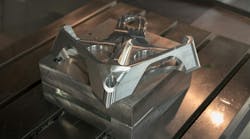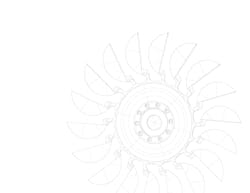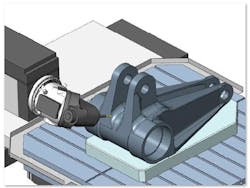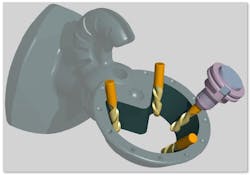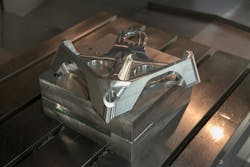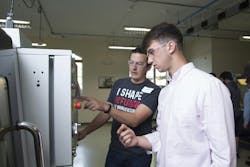In the realm of manufacturing, CNC programmers and machinists play a pivotal role in turning ideas into reality. Their commitment to innovation and technology drives progress across diverse industries, making them the unsung heroes behind the scenes. As we navigate our daily lives, we often encounter products and components that have been intricately shaped by the hands of these skilled individuals.
A CNC (Computer Numerical Control) machine reads G-code and M-code, which is the instruction provided by the machinist entered by hand or, more commonly, communicated to the machine by the CAM software that has applied the cutting strategy to the part that will be cut. These machines can cut a wide variety of materials, from plastics and metals, to wood and glass.
READ MORE: Protolabs Network’s Advanced Software Integration Offers Streamlined Collaboration
This article aims to delve into the world of multiaxis machining, exploring its definition, dispelling misconceptions and outlining the transformative benefits it can bring to your shop.
What is Multiaxis Machining?
Multiaxis machining, also known as 5-axis machining, represents a revolutionary approach to subtractive manufacturing. Unlike traditional 3-axis milling machines that operate along the X-, Y- and Z-axes, multiaxis equipment introduces A- and B-axes, allowing movement in multiple directions. The A-axis rotates around the X-axis, while the B-axis rotates around the Y-axis. This additional flexibility enables machining in four or more directions, with some advanced machines boasting up to nine axes.
The primary advantage of multiaxis machining lies in its ability to eliminate the need for multiple setups. The tool can reach any side of the part without requiring repositioning on the table. This reduction in setups not only saves time and money but also minimizes the potential for operator errors. Multiaxis machining proves particularly beneficial for industries such as aerospace, defense, automotive, energy and medical, where intricate parts with angled surfaces, complex geometries and tight tolerances are in high demand.
Dispelling Misconceptions
Despite its transformative potential, there are common misconceptions surrounding the adoption of multiaxis machining. Some shops may believe they lack the necessary equipment or skills, are hesitant to invest time in the perceived learning curve, or feel their existing processes are foolproof. It is crucial to debunk these myths and recognize that multiaxis machining can be a gamechanger for any shop willing to explore its capabilities.
Who Should Use Multiaxis Machining?
The versatility of multiaxis machining means that virtually any shop can benefit from its adoption. Whether operating in aerospace, defense, automotive, energy or medical fields, the technology caters to the evolving demands of modern manufacturing. Shops experiencing challenges with setup time or underutilizing existing multiaxis-capable machines should seriously consider integrating this advanced approach into their processes.
Making the Jump into Multiaxis
For those ready to embrace multiaxis machining, understanding a few key concepts is essential. Firstly, assess whether your current equipment has the capabilities for multiaxis machining. If not, explore the wide array of tools, holders and 5-axis machine options available in the market. Seek guidance from local manufacturing representatives to ensure a well-informed decision.
Additionally, consider the compatibility of your current CAM system with multiaxis capabilities. Upgrading your CAM system may be necessary, as most systems around the world support multiaxis machining. Select a system that aligns with your needs and budget and provides essential intangibles such as service, support and training.
READ MORE: How PLM Can Improve Supply Chain and Design Synergy and Move Goods Faster
Familiarize yourself with 3+2 machining, a stepping stone to 5-axis machining. This technique involves running a standard 3-axis milling program with the cutting tool tilted along one of the rotary axes. Mastering 3+2 machining before transitioning to full 5-axis machining can reduce costs, setups and cycle times.
Why Should You Embrace Multiaxis Machining?
As noted above, the initial intimidation associated with multiaxis machining can be mitigated by starting with 3+2 machining. This approach allows for a smoother transition into the world of multiaxis by running a standard 3-axis milling program with a tilted cutting tool. Not only does this reduce costs and setups, but it also lowers cycle times, making the overall process more efficient.
The benefits of multiaxis machining become evident as you realize its potential to minimize setups. 5-axis machines offer a broader range of motion, allowing them to machine around work-holding. This translates into increased accuracy and reduced human error, at the same time eliminating the need to design fixturing for each step in the process.
Improved surface finishes are another advantage of multiaxis machining. The ability to use alternative cutting tools, such as shorter tools with less vibration and deflection, results in superior surface quality. Additionally, the elimination of blend areas contributes to achieving truly remarkable surface finishes.
Transitioning into the realm of 5-axis machining expands the capabilities of your shop. You gain the ability to machine more complex parts, opening doors to projects that may have seemed unattainable before. The allure of multiaxis machining extends beyond its practical benefits; it captivates the imagination and interest of future generations in manufacturing, potentially inspiring them to pursue careers in the field.
Overcoming the Learning Curve
Contrary to popular belief, the learning curve for multiaxis machining is not as complex as one might think. Described by some as “just more mill,” the transition is facilitated by a wealth of information available online. Forums, YouTube videos, social media groups and other resources offer valuable insights into mastering multiaxis machining.
READ MORE: Mining for Answers: Tapping into the Product Data with Software & Systems
Seeking training, whether online or through local representatives, is crucial for a successful transition. Customized training tailored to your specific application ensures that you are properly equipped and educated to leverage the capabilities of multiaxis machining. Choosing tools with robust support and guidance from the businesses providing hardware and software solutions is essential for a seamless integration.
Conclusion
Becoming a multiaxis machining house requires an investment of time and resources, but the rewards far outweigh the costs. The perceived steep learning curve is surmountable, and the benefits—from taking on more complex work to reducing cycle times and enhancing profitability—make it a worthwhile endeavor. Multiaxis machining minimizes user error, decreases machining time and lead time, enhances repeatability and embraces cutting-edge technologies propelling the manufacturing industry forward.
In the competitive landscape of modern manufacturing, embracing multiaxis machining is not just an option; it’s a strategic move towards staying relevant and thriving in an ever-evolving industry.
Graham Hargreaves, marketing manager, CAD/CAM Consulting Services Inc., is a 15-year manufacturing industry veteran. CCCS provides sales, service, support and training in Southern California and surrounding areas for Mastercam, Desktop Metal, CGTech VERICUT and Verisurf.
